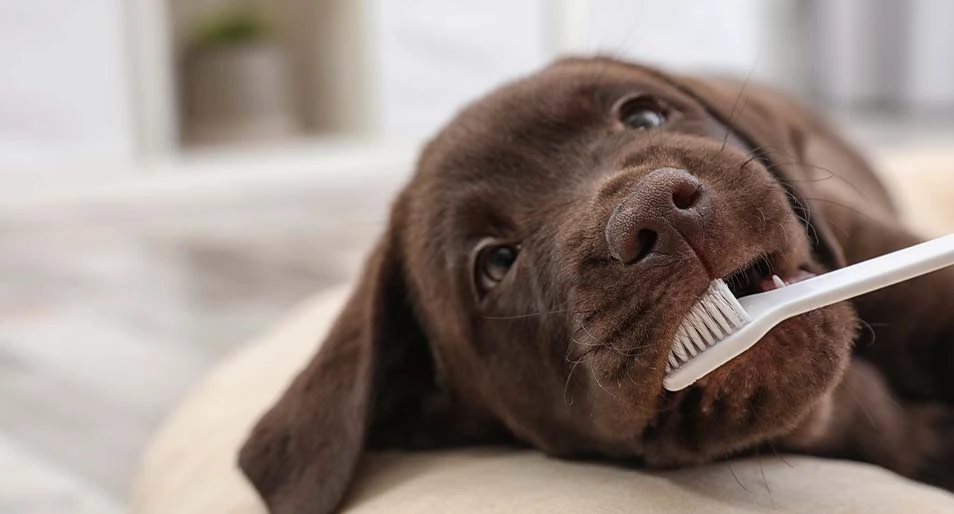PET HEALTH
How Much Does Dog Teeth Cleaning Cost?
The cost of a canine dental cleaning usually ranges between $300 and $2,000 for a standard cleaning.1 This can be an essential step to keeping your dog’s teeth and gums healthy, as regular dental care can prevent plaque buildup and more serious oral health issues — like gum disease and tooth loss.
Let’s take a look at the costs associated with cleaning your dog’s teeth and ways to save on canine dental cleaning costs. That way, you can be prepared to care for your dog’s dental health.
Ready to Insure Your Pet? Start Your Free Quote
What’s the Average Cost of Dog Teeth Cleaning?
On average, a standard dog teeth cleaning costs about $300 – $2,000, though the specific costs can vary based on your dog’s overall health, your location, and the level of care your pup needs. If your dog needs extra procedures, like tooth extractions or other types of oral surgery, the price will likely go up.1
However, there are ways to save on the costs of canine dental care. We’ll get to those later.
What’s Included in Dog Dental Cleaning Costs?
When you bring your pup in for a routine dental cleaning, you can expect the following to be included in the cost:2
- Pre-cleaning oral exam: The vet will manually examine your dog’s mouth to look for signs of periodontal disease or any other oral issues.
- Blood work: Many vets require blood tests before giving your dog an anesthetic to make sure their kidneys and liver are healthy.
- Anesthesia or sedation: Anesthesia helps keep your dog calm and comfortable during the cleaning, which can reduce their stress and make the process safer.
- X-rays: Dental X-rays are used to examine the state of your dog’s jaw, mouth, and the roots of their teeth. This allows the vet to identify problems they might not have found during the oral exam.
- Teeth scaling and polishing: The vet will remove plaque and tartar from your dog’s teeth, followed by polishing to smooth the surfaces and prevent buildup in the future.
To understand all of the costs associated with your dog’s dental cleaning, ask your veterinarian for an itemized bill. This can help you prepare to cover the costs of dental appointments as well as prepare you for future teeth cleanings down the road.
What’s not included in the cost of dog dental cleanings?
Some additional services may not be fully covered in the base cost of your dog’s dental cleaning. These can include tooth extractions or other surgical procedures that might be necessary if your dog has more serious dental problems. You may also have a separate bill for medications for pain management or treating infections after the teeth cleaning procedure.1,3
Specialized dental treatments for more advanced oral diseases might not be covered in the total cost of the dental cleaning. You may also have to pay for additional appointments if your dog’s teeth cleaning requires follow-up care from the vet.
What Factors Affect Canine Dental Cleaning Costs?
The cost of dog dental cleanings depends on several different factors, including:1,3
- Location: Veterinary costs are often higher in urban areas or places with higher costs of living than in rural regions.
- Dog breed: Certain breeds, like Yorkshire terriers and Chihuahuas, are prone to dental issues and may need more frequent cleanings, which can drive up the total cleaning costs.4
- Age of your dog: Older dogs may need more extensive cleanings or additional procedures because of age-related dental issues. These situations can make your overall dental bill higher.
- Size of your dog: Larger dogs may require more anesthesia, which can increase the final teeth cleaning costs.
- Severity of the dental issues: If your dog has pre-existing conditions, like a lot of plaque buildup, or needs additional procedures, like tooth extractions or root canals, the final cost will be more.
- Vet experience or specialty: More experienced veterinarians or specialty clinics may charge higher fees for their dental services.
Why Your Dog Needs Dental Cleaning
Like humans, dogs are prone to plaque and tartar buildup, which can lead to serious oral diseases if not addressed. One of the most common is periodontal disease. In its early stages, this disease causes painful gum inflammation.2
As periodontal disease progresses, the infection spreads into the tooth socket, damaging the roots and jawbone. This can cause the teeth to loosen and fall out, sometimes requiring surgery to remove infected bone.2
Over 80% of dogs ages 3 and older suffer from periodontitis.2 Fortunately, it’s preventable with regular dental care, including at-home cleanings and professional vet visits, starting when your dog is young.
How often do dogs need dental cleaning?
Most veterinarians recommend your dog get their teeth professionally cleaned at least once a year. However, some dogs may need more frequent dental cleanings depending on their age, breed, and overall dental health condition.4
Look out for signs that your dog may need a cleaning, such as bad breath, tartar buildup on their teeth, swollen or bleeding gums, or changes in eating habits. If you notice any of these symptoms, consult your veterinarian for advice on scheduling a cleaning.3
How To Save on Dog Teeth Cleaning Costs
Dog dental cleaning costs can add up, but there are several ways to save money while keeping your puppy's teeth in good shape. Here are some tips to help you keep those costs down.
Perform at-home dental care
Regularly brushing your dog’s teeth at home can be a great way to keep their teeth healthy while preventing more serious dental issues down the road. It’s recommended to clean your dog’s teeth at least two to three times a week, in addition to bringing them to the vet for a professional cleaning at least once every year.5
When brushing their teeth, be sure to use a pet-friendly toothbrush and toothpaste to reduce plaque buildup — especially around the gum line — and help keep their breath fresh.
Consider using dental chews or toys designed to promote oral health as well.3 These small efforts can make a big difference and help extend the time between dental cleanings with your vet.
Schedule regular dental checkups
One of the best ways to save on dental cleanings and avoid more expensive dental procedures is to schedule them regularly. By bringing your dog in for routine cleanings, you can prevent tooth decay and other serious oral health conditions that could lead to more expensive treatments down the road.3
Just like humans, dogs benefit from consistent dental care, which helps keep their teeth and gums healthy.
Consider pet insurance
Pet insurance can make a big difference in managing veterinary costs, including dental cleanings. With a dog insurance policy through MetLife Pet Insurance, you could get coverage that helps reduce your out-of-pocket expenses.
Regular dental cleanings are key to preventing serious dental issues, like periodontal disease, that can lead to bigger health problems affecting your dog’s heart, kidneys, or liver.2
Depending on your specific MetLife Pet Insurance plan, you could receive coverage for routine teeth cleanings. That way, you can stay on top of your dog’s dental health without worrying about the total cost.
Keep Your Dog’s Teeth Healthy With Pet Insurance
Regular dental cleanings are important for your dog’s overall health, but the costs can add up. Being proactive about cleanings can help prevent expensive procedures down the road. Pet insurance, like a policy through MetLife Pet, can help you manage the costs associated with your dog’s dental care.
With accident and illness coverage, you may be able to cover dental disease treatments, and depending on the terms of your policy, the Preventive Care add-on may even help reimburse6 you for your dog’s routine cleanings.
Get started with a free quote, and see how much you can save on your dog’s dental care.


